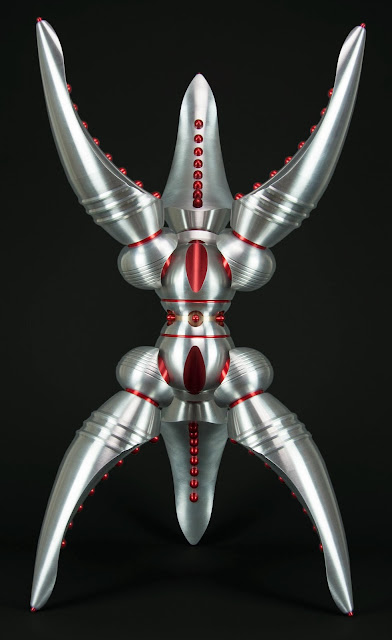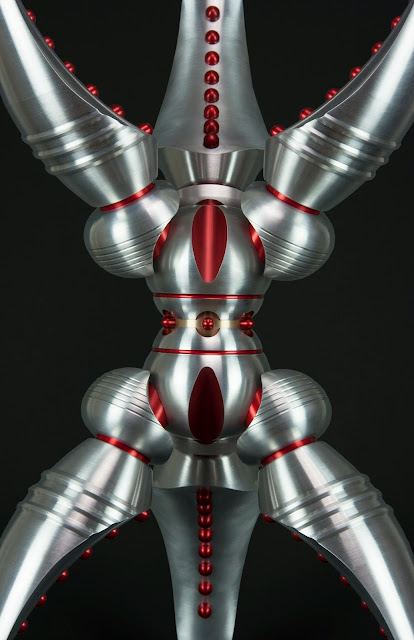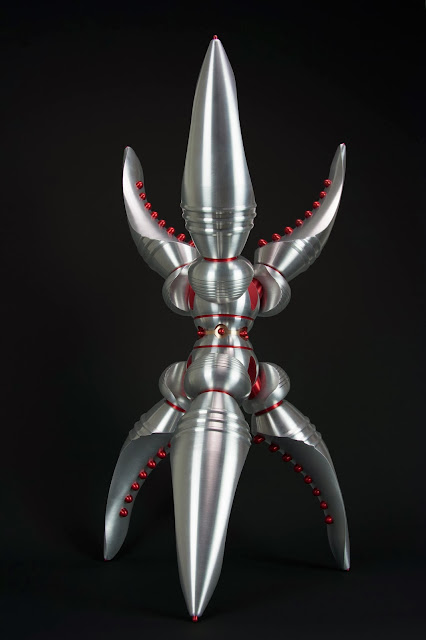Here is the latest entry in my ever growing list of machined sculptural works. Depending on how you count things, this one is #87.
I thought I would end the year working on two major pieces. This piece split off from a design I am currently in the process of building. I began fabricating both of them at the same time as they have a lot of overlapping machining processes, but I was able to complete this one much sooner.
Usually when I post about a new sculpture, I tend to keep my comments very factual and technically oriented. I rarely stray into conceptual territory when talking about specific works because most of my ideas relate to the body of work as a whole, rather than being strictly pinned to any singular piece. I thought I would deviate from this for a change and touch some things I have been thinking about.
I have been showing around early images of this piece, and as is sometimes the case, I have been getting a number of comments about how alien/sci-fi it looks to a few people. This does not necessarily bother me, and I certainly understand why this is sometimes the case. But I'd like to use this as an occasion to talk about this phenomenon, because depending on where you stand, this comparison can be problematic. Not just problematic for me as an artist, but for others who might see the work very differently.
First of all, I should say that it has never been my intention to explicitly make anything that could be classified as art deco, sci-fi, steam punk, or ray gun gothic. Not that I see anything wrong with any of these genres, it is just not the direction that I come at this from. I am quite ok with the knowledge that many people relate to the work in this manner, but I go out of my way to present my work in a neutral way so as not to steer interpretation in any single direction. I am glad that it brings people pleasure to view my work, no matter the context they bring to it.
But as I am sure many artist can relate, being categorized wholesale into one niche or another is never what one wants for their work. H.R Giger being the perennial example of an artist clearly marching to his own drummer, while for better or worse, cultivating a very large, Sci-fi centric following. He no doubt would want to be remembered for more than just his role in creating a few creature features in the late seventies/early eighties.
Part of the dilemma for me comes from wanting to make sure my art is judged on its own merits and isn't mischaracterized, but it is also the case that there persists a bias (in certain circles anyway) that from a fine art perspective, having your work labeled as steam punk or any of its counterparts, can be seen as a largely negative thing.
The argument (correct or not) is based on the assumption that sci-fi themed work is derivative and implies some sort of creative laziness on the part of the artist. That it is either a contrivance with niche appeal or some otherwise less than noble exercise of the mind. Unfair as it may be, it is simply looked down upon by some as being a bit low brow and not to be taken seriously as fine art.
I have a hard time with this, as there are no doubt plenty of examples that test this idea. Given the cultural overlap and genre mixing prevalent these days, I also suspect it would be near impossible to draw a distinct line between what does and does not fit this category in the first place. Assuming one of the criteria is that of the artists intent, whether or not I should concern myself with someone else's value system is arguable. However real the bias may be, I felt I should own the comparisons where they are justified, address were I think my work is unique and test the waters on what the impulse to default to sci-fi comparisons when discussing my work may really be about.
To start things off, I must freely admit there are undeniably a lot of shared visual elements that my process (that being machine work) produces that can easily be held up as looking distinctly ray gun gothic. There are forms conducive of machining that easily point back to what inspired earlier futuristic, or retro futuristic perspectives, it would be dumb to deny this. Certain visual elements are an inseparable part of the DNA of the processes that I use, but it is no different than the way all water color paintings share certain distinct characteristics. The difference being that there have been countless thousands of water colorists throughout history to establish visual norms, and I can count the number of machinist attempting to make fine art that I know of, on only one hand.
The most blunt way to say all this is simply "If you turn enough shiny metal things on a lathe, eventually something is going to look like a rocket ship to someone", so the comparisons are inevitable. Denying they exist or being defensive about it would be less than productive. I am much more interested however, in how new technology continues to evolve and change the way artists are able to employ manufacturing tools for purposes they were never intended. How innovation seems to be creating a space where machine work (along with many other industrial processes) can be explore for its visual applications rather than merely its utility. comparisons can easily be drawn to how the invention of slip casting put many potters out of work in the 18th century, but freed up the most skilled among them to explore their craft for its artistic merit.
It is a "standing on the shoulders of" and "forward looking" way of bending ones ideas through the lens of this ever evolving craft, not a backwards nod to the past. whether or not it looks like a rocket ship is a bit of a Rorschach test, and of little concern to me.
When I am planning my work, references to sci-fi imagery really don't factor. It is not willful ignorance, it is just that I am much more interested in the engineering challenges presented in building, operating, and maintaining the complex array of robotic equipment required to fabricate my sculptures and the design opportunities that they create for me. Dancing around history is a bit of a drag when it really has little bearing on the things you are most interested in. Working with metal, and trying to bend modern machine work to your will provides a creative frame work that I have never encountered anywhere else, and that is what keeps me so engrossed in what I do. Limiting myself based on concerns about how the work may be miss-interpreted would be too constraining. I just approach the work as honestly as I can, and hope the public will eventually catch up.
So I guess you can say that first and foremost, I think of my work in the context of my relationship to my tools, technology, and materials. How my personal aesthetic can be expressed through those particular constraints. In some ways, what I am doing may indeed be a similar reaction to a confluence of technology and innovation that inspired previous industrial art movements, but it is doing so within the context of the modern information boom and its technologically accelerating proliferation of digital fabrication methods. It builds on the story of how humans relate to their tools and materials, rather than being a direct reference to any one of those preceding genres.
A few examples include how automation tools designed for mass production can alter the way that we approach creating a single, one of a kind art object. Also, what it means for the arts and society at large when an artist of little means, working alone in Baltimore, can research, source, and buy all of the parts necessary to assemble a multi machine, fully automated, machine shop. Effectively scaling down numerous industrial processes so that they may be moved off of the factory floor, and into the artist studio to be used purely as a means of self expression.
I have always been leery about stating too forcefully what my work is about because there are just too many threads and competing ideas, but I think that gets to the heart of the problem of summing up my work as simply a derivative science fiction homage.
In the end however, I think most of this is mute. Viewers tend to bring with them what they know best when viewing any particular piece of art, and so an artist ability to precisely control how his or her work is viewed is limited in a lot of ways. For some, science fiction is simply where they are coming from, and so it is only fitting that it is the lens they use to view the work. I have talked to physicists, architects, jewelers, boat captains and people from all manner of backgrounds, they all tend to see the work and relate to it through their own particular world view. Every one of them has a unique perspective on my sculpture and they each have wonderfully insightful things to say that I would never have thought of myself. Frankly, I wouldn't have it any other way, having only one correct answer is kind of outdated and boring.
So then the question still remains, what is my intention, if it is not some vague illusion to some other genre or art movement? well it is sort of the exact opposite of that. The fact that my work defies easy categorization is one of the most intentional aspects about it. I enjoy operating in this visual grey area where the work refuses to completely transform into anything particularly identifiable, nor does it give away any clues to its possible utility, and this is with very good reason.
One thing I have noticed over the years, is that when people interact with objects in a normal context, (very precise, overly engineered objects in particular) their first instinct is to assume it must do something (which is very natural). In order to get at what that "something" is, they do a very quick comparison to things they already know in order to identify or categorize the thing they are seeing, be it a can opener, coffee pot, ect. This makes good sense, we usually need to know how we are to interact with objects we encounter, and past experience is how we predict what unknown things will yield, it is how we make our way through the world, even in unfamiliar environments.
We are also very accustom to the objects we encounter on a day to day bases giving us easy clues as to what they are, or what they are to be used for, so when these clues are absent, it can be more than a little unnerving to some. By omitting these cues in my work, I intentionally exploit this phenomenon, often to great effect. As a commenter recently observed on my Facebook page "The form is so artificial (non-natural) it screams intentional design, which implies purpose, yet the unfamiliarity of the form compared to our commonly understood objects feels like an unresolvable paradox"
So in some sense you could say that I intentionally design objects that seem alien, but when I say that, I am using the term "alien" in its original "foreign" context and not necessarily the more contemporary science fiction understanding of the word.
This intentional vagueness imparted to the work and people's instinctive desire to seamlessly understand and categorize things can become very problematic when looking at art, and certain kinds of abstract work in particular. It can work both for you, and against you.
It has been my observation that the easier your work is to identify, or solve, the quicker people can put your work into its proper mental box and move on to the next thing. It is why, for example, people immediately start throwing out guesses as to what they think one of my pieces resembles. People will say "It's a lamp", or "R2D2", which is all fine and well as it is an honest attempt to understand what one is seeing.
It has been my observation that the easier your work is to identify, or solve, the quicker people can put your work into its proper mental box and move on to the next thing. It is why, for example, people immediately start throwing out guesses as to what they think one of my pieces resembles. People will say "It's a lamp", or "R2D2", which is all fine and well as it is an honest attempt to understand what one is seeing.
But even in a broader fine art context, people will immediately try and place a work into its proper canonical place, to file it neatly under categories such as "collage" or "found object" art. The more difficult you make this process for people, the longer and harder they have to think about your work to pin it down. This can work in your favor as the longer their minds have to chew on what you have created, the longer it will feel fresh in their minds, which is very positive and the point.
But one of the side effects of this, especially in the case of my work, is that many people default very quickly to something familiar, even if it is not a good match. For example, in my case, some will move quickly to steam punk. Some of this can be attributed to a lack of knowledge about what goes into creating each work, and some of it has to do with preconceived notions about what abstraction looks like in a historical sense. most of us have had it drilled into us that expressionism and minimalism are the cardboard stand-ins for that particular category in our minds. So in some ways, the leap to science fiction is an easier way of saying something is abstract and also difficult to define without looking quite like a Jackson Pollock or a Frank Stella.
But one of the side effects of this, especially in the case of my work, is that many people default very quickly to something familiar, even if it is not a good match. For example, in my case, some will move quickly to steam punk. Some of this can be attributed to a lack of knowledge about what goes into creating each work, and some of it has to do with preconceived notions about what abstraction looks like in a historical sense. most of us have had it drilled into us that expressionism and minimalism are the cardboard stand-ins for that particular category in our minds. So in some ways, the leap to science fiction is an easier way of saying something is abstract and also difficult to define without looking quite like a Jackson Pollock or a Frank Stella.
My work intentionally borrows a lot from its process, utilitarian objects, and other industrial engineering cues, it is a kind of formal abstraction interwoven with my fascination for human psychology, technical innovation, and logistical problem solving, yet it does not fit neatly into what we are used to seeing when we throw around the term "abstract". So in a lot of ways, it is completely logical to have my work compared to other sci-fi aesthetics, because it means by one measure, I am being very successful in what I have set out to do, which is to keep people engaged about what it is they are seeing.
I am sure my thinking on this will continue to evolve, but for now I think that is a good a place to start. I hope you will consider the new piece in this context and I welcome any discussion that arises from it.
Now,back to the nuts and bolts of the new piece.
The work itself is quite large by my standards, it stands approximately 26" tall and sweeps out a 16" circumference. I haven't thrown it on a scale yet, but I would guess about 35 pounds.
I have been using my home made 3D printer more and more to work out my designs in real space, so I thought I would show off one of the models I made while finalizing the design for this piece. Its kind of nice to think that even after the sculptures themselves are sold, I will still have these models as a record for my personal collection.
As always, please feel free to comment or email me with questions.
Also, Thank you Barrett Lewis for the comment quoted above.









